Abstract
St. Vincent and the Grenadines has emerged as a notable player in global fruit agriculture, particularly with its impressive yield of 795 kg per hectare in 2021. This high productivity reflects a combination of favorable climatic conditions, fertile volcanic soil, and traditional farming practices that prioritize sustainability. Historically, the Caribbean region has focused on tropical fruits such as bananas, mangoes, and avocados, with local farmers adapting to changing market demands and climate challenges. Over the years, investments in agricultural technology and infrastructure have further enhanced productivity. Despite facing issues like natural disasters and fluctuating market prices, St. Vincent’s agriculture sector continues to evolve, contributing significantly to the local economy and food security.
Domestic fruit supply/population (worldwide)
The Dominican Republic’s record fruit yield of 833 kg per hectare in 2018 highlights its robust agricultural sector, characterized by diverse tropical fruits, including bananas, pineapples, and avocados. Over the decades, the country has leveraged its rich volcanic soil and favorable climate to enhance productivity. Since 1961, there has been a steady upward trend in fruit yields, driven by advancements in agricultural techniques, improved pest management, and increased investment in infrastructure. Dominica, currently at 89.5% of its peak yield, reflects a commitment to maintaining productivity despite challenges like climate change and natural disasters. This resilience underpins the country’s role in regional food security and economic stability.
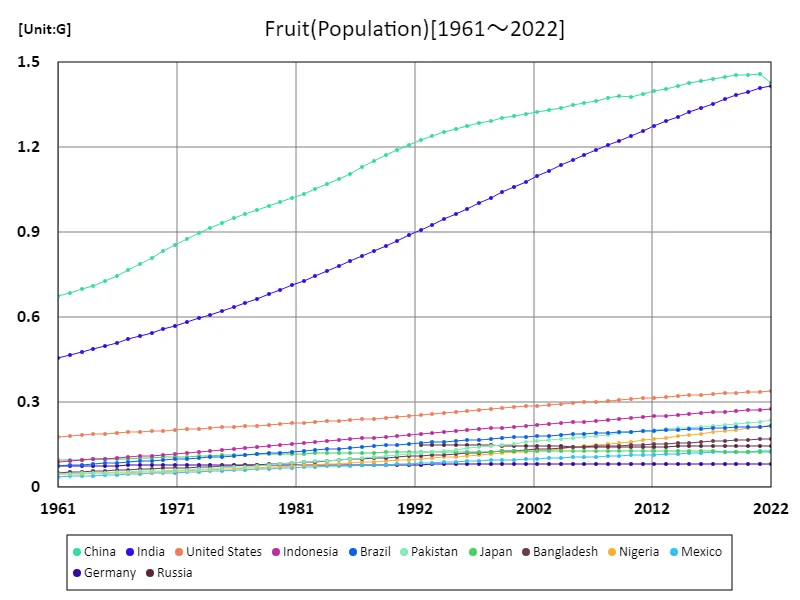

The maximum is 1.46G[2021] of China, and the current value is about 97.8%
Domestic fruit supply/population (latest year, countries around the world)
In 2021, St. Vincent and the Grenadines stood out in world agriculture with a remarkable fruit yield of 795 kg per hectare, significantly above the global average of 118 kg. This high productivity is attributed to the island’s rich volcanic soil, favorable climate, and a strong focus on sustainable farming practices. Historically, the country has cultivated a variety of tropical fruits, such as bananas, mangoes, and citrus, catering to both domestic and export markets. The total production of 21.5 tons illustrates the potential for agricultural growth despite challenges like climate change and natural disasters. Overall, St. Vincent’s agriculture sector continues to adapt and innovate, ensuring food security and contributing to local economies.
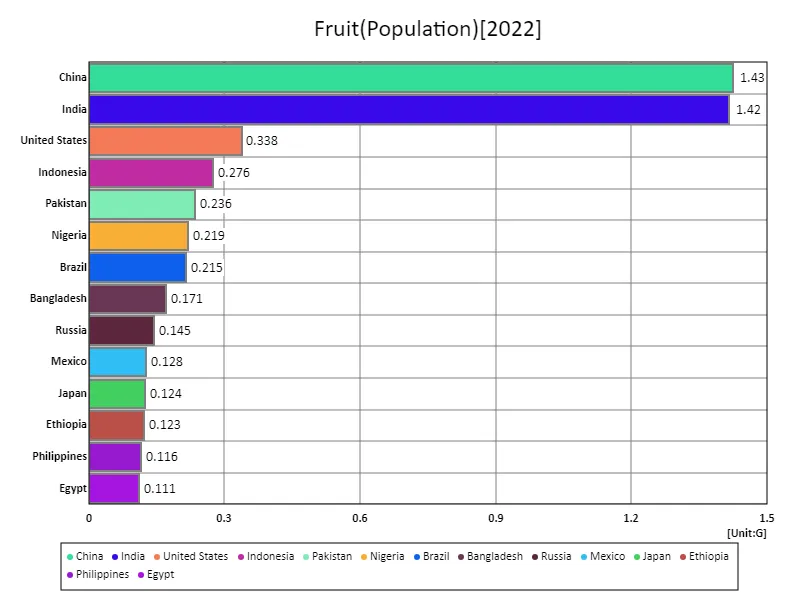

全体の最大はChinaの1.43Gで、平均は41.4M、Totalは7.9G
Domestic fruit supply/population (continent)
In 2021, Oceania recorded the highest agricultural fruit yield at 197 kg per hectare, reflecting the region’s unique climatic conditions and agricultural practices. Characterized by diverse ecosystems, Oceania benefits from both tropical and temperate environments, enabling the cultivation of a wide range of fruits, including citrus, avocados, and kiwis. Over the years, there has been a trend toward sustainable farming methods, with an increasing emphasis on organic practices and conservation. Investments in technology and infrastructure have enhanced productivity and market access. Despite facing challenges such as climate variability and invasive species, Oceania’s fruit sector continues to adapt, contributing significantly to both local and export markets.
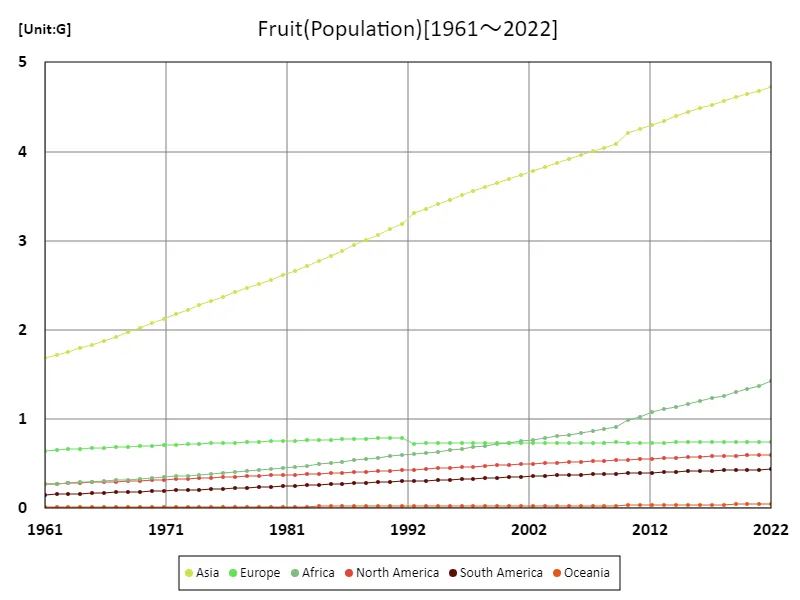

The maximum is the latest one, 4.72G of Asia
Domestic fruit supply/population (latest year, continent)
Looking at the domestic supply of agricultural fruits in 2021, North America is the largest at 176 kg. This shows that the North American region is blessed with high productivity and diverse fruit production. In this region, warm climates and rich agricultural technologies contribute to fruit production. It is also able to respond quickly to changes in demand and supply a variety of fruits. On the other hand, other regions and countries also have their own unique characteristics. Supply varies depending on climatic conditions, geographical factors, and agricultural policies. For example, tropical regions mainly produce tropical fruits such as mangoes and pineapples, and supply tends to be relatively high. Changes in demand also affect supply. Due to the increasing global health consciousness and diversification of food culture, demand for certain fruits is increasing. In response, producing countries may adjust production to meet demand. Overall, domestic supply of agricultural fruits varies by region, and changes in climatic conditions and demand affect the supply. Some countries are working to improve productivity and increase supply by introducing sustainable agricultural practices and technological innovations.
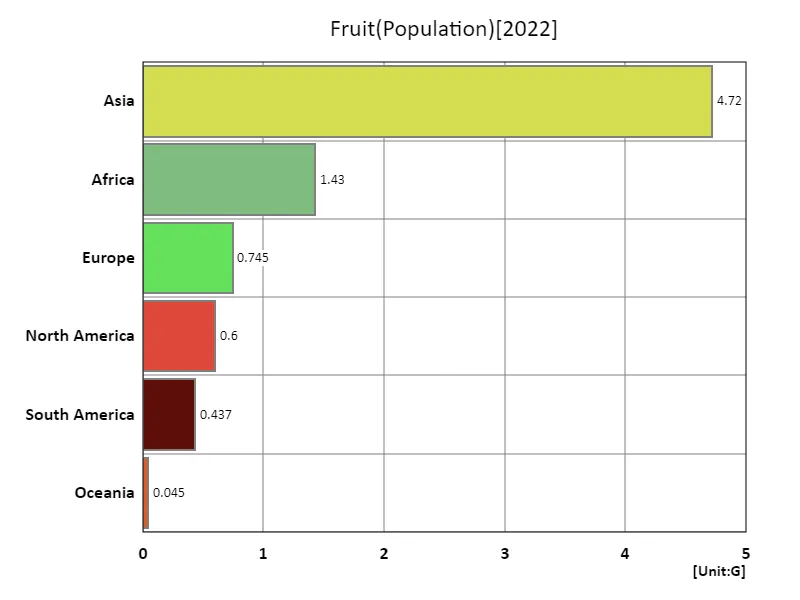

The maximum is 4.72G of Asia, the average is 1.33G, and the total is 7.98G
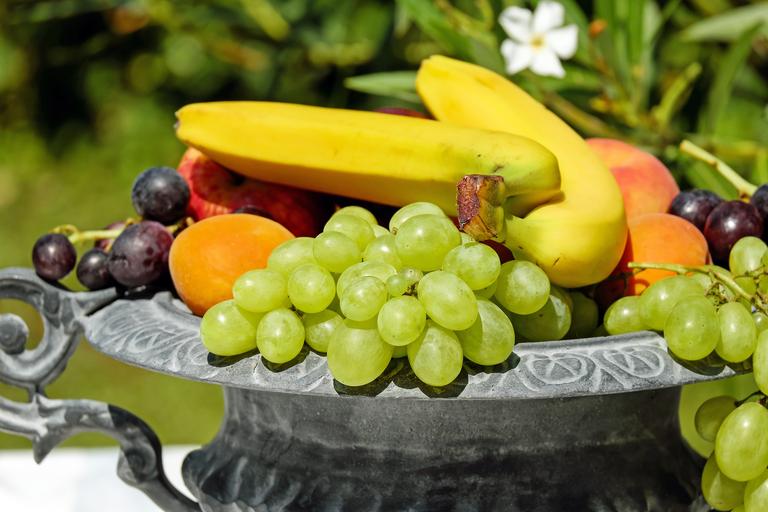


Comments